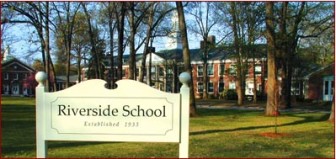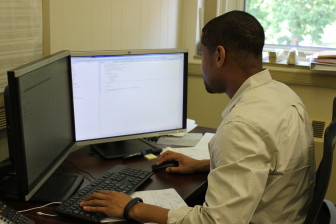What do you think of when you imagine the school of the future? For some these words might conjure up robot teachers, paperless classrooms, space-age technologies, lightning-fast connections.
Although we might be a long ways away from a scene out of a science fiction movie, the ideas behind that image aren’t as far off as one might think: an image of an education characterized by exploration, uninhibited by limitations.
For Phillip Dunn, Director of the Digital Learning and Technology at the Greenwich Board of Education, that image starts and ends with the Digital Learning Environment initiative.
After graduating from Bronx High School of Science, Dunn studied Mathematics at Cornell and then attended Columbia for grad school. From there, he taught math in the New York Public School system, he worked as a web designer and IT consultant in New York for clients like MetLife and then another group in Connecticut, he ran the Human Relations information system for the New York Department of Schools, then took on a job as Chief Information Officer for Stamford Schools before taking on his current position with the Greenwich Board of Education.
Seated with Dunn in his office, it becomes clear Dunn isn’t just armed with big ideas for Greenwich Public Schools, but the plans to back them up. Coming from a strong background in technology and education, Dunn is passionate about the changes Digital Learning will bring. In a nutshell, he explains, “We’re trying to put a device in every staff member and student’s hands in the district and we’re also rolling out some new data systems and providing professional learning to teachers.”
It quickly becomes clear this process is much more complex than it sounds, with the scope of his job also encapsulating everything that goes into budgeting for these changes, IT repairs on the current system, monitoring network topology, putting in fiber optic cabling, and so on. There is what he refers to as “fire fights” in the day to day, having to focus on immediate issues or failings in the tech department as well as the long term goals. He also oversees smaller tactical projects that facilitate his work, like the app and website interns are creating to communicate the ongoings of the initiative.
“The day to day is intense because there’s so many facets, not just to this initiative, but also to just keeping the lights on,” Dunn explains. “We’re in a system that serves almost 9000 students, 1000 staff members, so providing technology services to each of them takes a lot of preparation.” What was initially a 5 year, 17 million dollar initiative, the Digital Learning Environment has since evolved into a 6 year, 13 million dollar initiative, thanks to the strategizing efforts of Dunn and his team.

Riverside School, one of the first schools to implement DLE. Credit: Greenwich Schools
The plan takes a phase approach: phase one involved working with Riverside and Hamilton Avenue Schools. The second phase focuses on the middle schools, while phase three is system-wide implementation. The goal is to have full implementation by the ’15-’16 school year, meaning the first three years of the initiative are devoted to implementation, while the next three are devoted to refining, maintaining, and sustaining. “Sometimes when you try to do everything at once, you get nowhere,” Dunn remarked on the necessity for phase implementation.
When asked about the biggest obstacle the initiative had faced, he said, “The scope of what we’re trying to do is certainly challenging in and of itself. In one year we tried to completely change every aspect of the educational service in two schools, Hamilton Ave and Riverside. And I think we were pretty successful at that. I like to say if you walked into one of the schools one day, before we did anything with digital learning, it looked one way, and then after we deployed devices and professional development and gave a system to support all of it, it looked like we stepped three years into the future.”
In Riverside and Hamilton Ave, students were given individual iPads that they could take from class to home. Every device comes with a standard set of apps, referred to as the “digital toolbox”. Educreations, a video-creating application, allows students to share videos with others or record for themselves videos and tutorials of them explaining a concept. Math game applications allow students to practice different math skills. The application schoology allows students and teachers to communicate effectively through the sharing of assignments and feedback. None Ullman, the project manager for Digital Learning Environment, explains that while it might be natural to see how the initiative can improve math skills, it is also expected to make a serious impact in writing and reading comprehension. Tools like Google Docs allow teachers to observe the entire writing process, and students and teachers can comment back and forth on the digital document to understand what changes should be made. “What teachers are finding,” Ullman explains, “is that the feedback is coming earlier and it’s more descriptive and just in time, and then students are writing more and writing better.” Students also have access to software that helps with reading and vocabulary all the time, whereas they used to be scheduled time once a week in computer lab. Students are learning vocabulary faster, and are able to understand what they’re reading better.
This initiative is about far more than just giving a device to every student. With the addition of these technologies comes focus on how they can be used to change the teaching process, and how they can be used to change the relationship between teacher, student, and content. Dunn says, “The touchstone of this initiative is empowering teachers with the tools, and really empowering students with the tools, to give them greater student learning, greater student achievement, and accelerated student achievement with students that aren’t where they need to be right now.”
This is illustrated in the five project goals, which provide an overview into all this project seeks to accomplish. The first goal is to have students as critical thinkers, particularly of online content. “When events happen they happen in real time, online, and history is writing itself every second,” Dunn noted. “So we want students that can process the world using these tools.” The second goal Is self regulated learning. As Dunn explains, “In the modern workplace there’s no longer an expectation on a job that you get work from your boss. The reality of most workplaces is that we expect people to be able to find opportunities for improvement and then create that improvement everywhere that they go.” The third goal is quality feedback, which comes from strengthening the communication loop between teacher and student with online resources. The fourth goal is personalized learning, as Dunn defines, “The way you explain it to yourself is your personalization, your ownership of how you understand the concept. And the highest level of personalization, I believe, is when you can then teach other people.” And the fifth and final goal is SBAC (Smarter Balanced Assessment Consortium) readiness, which just goes towards meeting the common core curriculum.

“The touchstone of this initiative is empowering teachers with the tools, and really empowering students with the tools, to give them greater student learning, greater student achievement, and accelerated student achievement with students that aren’t where they need to be right now.”-Phillip Dunn
As far as the necessity for these goals, Dunn expands, “The U.S. curriculum is often criticized for living entirely within the realm of fact, and sometimes analysis. When I was a kid they made us do a lot of rote memorization, and if you did that you were an A student. What we’re going toward, to reflect the modern world, is the modern world is all about, how are we solving problems for people? How are we adding value? How are we synthesizing solutions? So the common core curriculum is trying to ratchet up that cognitive process of US education and make everything oriented towards synthesis. If you can create something from a factual basis of ideas that you’ve analyzed, then you’ve really learned it, when you can create your own novel expressions of it.”
_____________________________________

Subscribe to the daily Greenwich Free Press newsletter.
_________________________________
People also need not worry about the loss of the tactile benefits that come from interacting with pen to paper. “We’re also very mindful that when you’re dealing with students, particularly younger students, we’re charged with their emotional and social development. These students are also in some senses developing fine motor skills. So we don’t want to replace their entire world with something digital. We still want them to touch paper and still have that experience of really creating an atmosphere around what they’re reading, what they’re studying. So where it makes sense, we’ll go digital, and where it doesn’t make sense and there’s a great experience to offer, we’re going to offer that great experience.”
At the end of the day, this is not a story about the technological changes so much as the people at its core and all the benefits students can hope to gain. Dunn says, “We believe that people are really at the heart of the education equation,” and it is through this understanding that the true benefits of the initiative can be observed. He recalls when, during his time as CIO of Stamford schools, he went to go visit a program called Apples– an integrated preschool where students with special needs attend seamlessly with traditional students. There he saw a young girl going through images on a tablet, and with each swipe, her face would light up with joy. He asked a teacher what she was looking at, and the teacher explained that she was looking at pictures of herself. The little girl had never understood what her birthday was because she was hard of hearing and so it couldn’t be explained, until they collected pictures of her every year celebrating her birthday and showed them to her. “There wasn’t a dry eye in the room,” Dunn recalls, “And I said, this is it, this is why we need to be digital.” This story illustrates the Digital Learning Environment at its core; regardless of different needs, the tools are there to facilitate each individual’s unique understanding and learning. And now because of DLE, Dunn observes, “A student at Hamilton Ave today will be able to forever look back at the moment they understood something this year.”
Related Stories:
Digital Learning at Hamilton Ave School: Tiny Fingers Flying Across Devices
Learning ABC….and DLE. iPads Distributed at Ham Ave and Riverside Schools
____________________________________

Email news tips to Greenwich Free Press editor [email protected]
Like us on Facebook
Twitter @GWCHFreePress
Subscribe to the daily Greenwich Free Press newsletter.